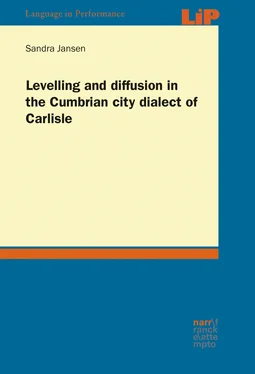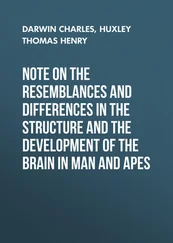Sandra Jansen
Levelling and diffusion in the Cumbrian city dialect of Carlisle
Narr Francke Attempto Verlag Tübingen

© 2018 • Narr Francke Attempto Verlag GmbH + Co. KG
Dischingerweg 5 • D-72070 Tübingen
www.narr.de• info@narr.de
Das Werk einschließlich aller seiner Teile ist urheberrechtlich geschützt. Jede Verwertung außerhalb der engen Grenzen des Urheberrechtsgesetzes ist ohne Zustimmung des Verlages unzulässig und strafbar. Das gilt insbesondere für Vervielfältigungen, Übersetzungen, Mikroverfilmungen und die Einspeicherung und Verarbeitung in elektronischen Systemen.
ePub-ISBN 978-3-8233-0091-5
For its novelty to the newcomer,
its variety and its preserving so much that is historical,
Carlisle’s must surely rank as one of the
most interesting city dialects in the British Isles
(Wright 1978: 15)
This is a sociophonetic study of speakers from Carlisle, Cumbria in the far north west of England, an area which has had little attention from a dialectological and variationist sociolinguistic point of view. Language change in the community is studied by investigating variation in the speech of adults of different ages. The results are set in the context of geolinguistic processes, i.e. geographical diffusion and dialect levelling. These are mechanisms in dialect contact situations which lead to language change.
The thesis examines six phonological features of Carlisle English in a variationist sociolinguistic framework. Auditory and acoustic methods as well as statistical modelling are employed to investigate processes of language change. The following research questions are addressed:
Which geolinguistic processes are observable?
How does linguistic variation pattern across the social categories age, sex and social class in Carlisle English?
Is variation leading to language change? If so, are these changes led by internal or external motivation?
Can geolinguistic processes explain variation and change in the linguistic system of Carlisle English?
The book is structured as follows:
Chapter 2presents the theoretical framework of this study. I concentrate on a dialect contact framework since dialect contact (often due to mobility) is responsible for various changes that have occurred and are occurring in varieties across the north of England. Of considerable interest is Trudgill’s (1986) seminal work Dialects in Contact . Processes such as geographical diffusion and dialect levelling are identified as key processes in dialect contact scenarios. Moreover, external an internal factors of language change are discussed.
Chapter 3introduces Carlisle as research site comprising essential geographic, demographic and historic background information.
Chapter 4provides a detailed account of the data collection and highlights relevant issues in connection with the fieldwork.
In chapter 5the variation of the following phonetic variables is discussed:
The first of these variables is the degree of fronting of the GOOSE vowel. In addition, results of possible fronting of GOAT and FOOT are discussed in relation to the GOOSE vowel. For studying variation and change in Carlisle English vowels, acoustic phonetics as a mean of measuring variation has been chosen.
The use of (T) in intervocalic and word-final position such as butter or hat but not in word-initial position such as tea is analysed. In contrast to the vowel variables, the consonant variables are studied by auditory means.
The use of (R) in words such as red , merry and free is considered. However, /r/ in final or pre-consonantal position (rhoticity) such as pair or park are not taken into account here.
The use of voiced and voiceless variants of (TH) in words such as other , breathe , three, something and north is analysed.
The sociolinguistic variables have been selected because of their ubiquity in northern English varieties due to diffusional mechanisms (e.g. Burbano-Elizondo 2006; Llamas 2007; Atkinson 2011; Flynn 2012). One goal is to observe whether these features are already part of Carlisle English despite Carlisle’s geographical distance from London. Another goal will be to see if a change in progress is observable. The diffusional mechanisms within the community but also in relation to other urban areas in close proximity to Carlisle will be taken into account.
In chapter 6the results obtained in chapter 5 are discussed and common themes are identified. They are related to theories and findings in the literature on language variation and change. The research objectives proposed in this chapter are revisited in the light of the results. In addition, the results are linked to social practice in Carlisle English. The analysis of social practice of people can yield important insights into the linguistic behaviour.
The conclusion in chapter 7completes the book.
This thesis draws on sociophonetic methods. The study provided here describes variation and change processes in Carlisle English. Dialect contact is an important factor in dialect change and this is the starting point for this study. I investigate changes in Carlisle English which are due to dialect contact scenarios, in particular the geolinguistic processes diffusion and levelling .
This part of the chapter deals with the dialect contact framework. Dialect contact due to mobility lies at the heart of the geolinguistic processes diffusion and levelling which have been discussed widely in the sociolinguistic literature in recent years (e.g. Trudgill 1986; Britain 2002; Kerswill 2003; Steele 2008; Atkinson 2011; Flynn 2012).
Mobility increased dramatically over the course of the 20 thcentury and is a major part of today’s society. Increased mobility leads to an increase in contact between individuals from different geographical and social areas and thus to the increase of dialect contact scenarios which Trudgill (1986: 1) defines as “contact between varieties of language that are mutually intelligible.”1 Possible contact scenarios are when people go on holiday or when they travel to the next bigger city for shopping or for cultural events. These are rather short-term contacts and are often discarded in dialect contact research while commuting and moving can be interpreted as long-term contact situations which can lead to and further language change. But not only mobility can influence language change. The area that people orient themselves towards or away is also an important factor (cf. Montgomery 2012; Leach, Watson and Gnevsheva 2016). Britain (2010b) emphasises social practice, attitudes and orientation as key factors for dialect change scenarios.
In the following part I present various processes that are related to dialect contact scenarios.
Accommodation has to be seen as a supposition in dialect contact scenarios. It refers to the linguistic changes on the individual level in short-term contact situations. In general, speakers tend to modify their speech towards or away from their interlocutor. This hypothesis is put forward by Giles and Powesland (1975 quoted in Trudgill 1986) in the communication accommodation theory . Their explanation for such behaviour is similar to positive politeness strategies found on the pragmatic level.
Читать дальше












